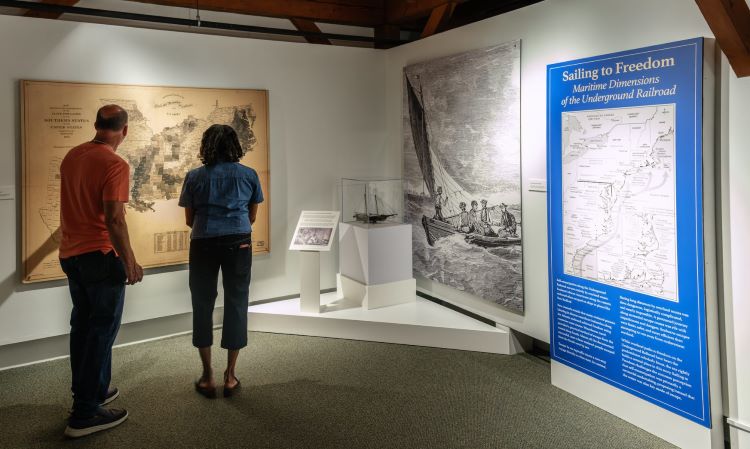
Sailing to Freedom: Maritime Dimensions of the Underground Railroad
Sailing to Freedom: Maritime Dimensions of the Underground Railroad highlights little-known stories and describes the less-understood maritime side of the Underground Railroad, including the impact of African Americans’ paid and unpaid waterfront labor. Self-emancipation along the Underground Railroad was not entirely by overland routes. A great number of enslaved persons made their way to freedom using coastal water routes along the Atlantic seaboard, including the Chesapeake Bay. Enslaved African Americans often escaped by sea aboard merchant and passenger ships, or smaller watercraft. Based upon the book, “Sailing to Freedom,” the exhibition expands the understanding of how freedom was achieved by sea and what the journey looked like for many African Americans.
In Sailing to Freedom, guests will meet figures like Henry “Box” Brown, who escaped to freedom in 1849 by arranging to have himself mailed in a wooden crate to abolitionists in Philadelphia. This summer, teens in CBMM’s Museum Masters camp constructed a recreation of Brown’s crate for the exhibition, basing their design on descriptions from historic manuscripts.
The exhibition’s storytelling is supplemented by artifacts curated from CBMM’s collection and other sources. This includes a log canoe model representing boats used by freedom seekers in the mid-1800s, tools used by enslaved people working in the shipbuilding trade, and a painting of the Baltimore Clipper Young Brutus showing Black mariners on deck.
A portrait of the ship Katherine Jackson, which transported 272 African Americans sold from Maryland and Washington, D.C. to sugar plantations in Louisiana, reveals the dark history of enslavement, while a quilt crafted by members of the National African American Quilt Guild, on loan from the Baltimore-based Universal Sailing Club and commemorating the 10th anniversary of the Souls at Sea remembrance ceremony, depicts 14 ships that transported captive Africans as part of the slave trade.
Sailing to Freedom was curated by New Bedford Whaling Museum Curator of Maritime History Michael Dyer and the University of Massachusetts-Dartmouth’s Timothy Walker, who edited the book that serves as source material. Major funding was provided by the National Endowment for the Humanities through the New Bedford Historical Society, with support from numerous community partners, and is brought to CBMM with assistance from the Portsmouth Museums (Va.).
Comments Are Welcome
Note: We moderate submissions in order to create a space for meaningful dialogue, a space where museum visitors – adults and youth –– can exchange informed, thoughtful, and relevant comments that add value to our exhibits.
Racial slurs, personal attacks, obscenity, profanity, and SHOUTING do not meet the above standard. Such comments are posted in the exhibit Hateful Speech. Commercial promotions, impersonations, and incoherent comments likewise fail to meet our goals, so will not be posted. Submissions longer than 120 words will be shortened.
See our full Comments Policy here.